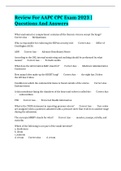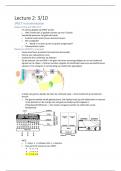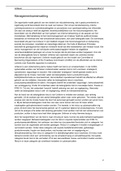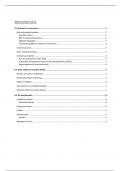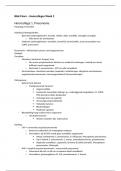Blood pressure reach 140/90mmHg or greater for the first time
PREGNANCY INDUCED after Midpregnancy but proteinuria is not identified. Half of
these patient subsequently develop preeclampsia syndrome.
HYPERTENSION Gestational hypertension is reclassified by some as <transient
Course Outline hypertension= if evidence for preeclampsia does not develop
and blood pressure returns to normal by 12 weeks postpartum.
❖ TYPES OF PIH
❖ DIAGNOSIS OF HYPERTENSIVE DISORDERS
PRE-ECLAMPSIA
❖ GESTATIONAL HYPERTENSION
❖ PRE-ECLAMPSIA Summary:
❖ PREECLAMPSIA SUPERIMPOSED ON CHRONIC
HYPERTENSION ▪ Hypertension, proteinuria, edema
❖ RISK FACTORS
▪ The new onset of htn and proteinuria or htn and end-
❖ ETIPATHOGENESIS
organ dysfunction with or without proteinuria.
❖ PHENOTYPIC EXPRESSION OF PREECLAMPSIA
SYNDROME ▪ Caused by placental and maternal vascular and always
❖ ETIOLOGY resolves after delivery
❖ PATHOGENESIS ▪ Increase risk of cardiovascular disease
❖ PATHOPHYSIOLOGY ▪ Increases in systolic and diastolic blood pressure can
❖ PREDICTIVE TESTS be either normal physiological changes or signs of
❖ ECLAMPSIA
developing pathology.
❖ OBSTETRIC MEASURE
❖ PREVENTION
It is described as pregnancy-specific that can affect virtually
❖ EARLY DIAGNOSIS OF PREECLAMPSIA
❖ EVALUATION OF PREECLAMPSIA every organ system. Much more than gestational hypertension
❖ CLINICAL MANAGEMENT OF PREECLAMPSIA with proteinuria, appearance of proteinuria remains an
❖ MANAGEMENT CONSIDERATIONS OF important diagnostic criterion. Other diagnostic criteria are the
PREECLAMPSIA following: thrombocytopenia, renal dysfunction, hepatocellular
❖ LONGTERM CONSEQUENCES necrosis, CNS perturbations, and pulmonary edema.
TYPES OF PIH: INDICATORS OF PREECLAMPSIA SEVERITY
(1) Preeclampsia and eclampsia syndrome ✓ Headaches or visual disturbances such as scotomata
(2) Chronic hypertension of any etiology can precede eclampsia
(3) Preeclampsia superimposed on chronic hypertension ✓ Epigastric pain or RUQ pain accompanies
(4) Gestational hypertension hepatocellular necrosis, ischemia, and edema.
Accompanied by elevated serum hepatic transaminase
DIAGNOSIS OF HYPERTENSIVE DISORDERS levels.
✓ Thrombocytopenia. Represents platelet activation and
Hypertension is diagnosed when blood pressure exceeds aggregation as well as microangiopathic hemolysis.
140mmHg systolic or 90mmHg diastolic. Eclamptic seizures ✓ Renal or cardiac involvement
develop in some whose blood pressure have stayed below ✓ Obvious fetal-growth restriction
140/90mmHg. A sudden rise in mean arterial pressure but still ✓ Early-onset disease.
in normotensive – <delta hypertension= – may signify
preeclampsia PREECLAMPSIA SUPERIMPOSED ON CHRONIC
HYPERTENSION
Delta Hypertension is when there is an acute rise in blood
pressure. Some women will go on to have obvious ▪ Chronic underlying hypertension is diagnosed in women
preeclampsia, and some develop eclamptic seizures or HELLP with documented blood pressure > 140/90mmHg before
while still in normotensive. pregnancy or before 20 weeks gestation or both
▪ Blood pressure normally drops during second and early
GESTATIONAL HYPERTENSION third trimesters in both normotensive & chronically
hypertensive women.
Preeclampsia does not develop and hypertension resolves by
12th week postpartum.
Downloaded by Purity Kimani ()
, lOMoARcPSD|11232395
▪ During third trimester BP return to their originally ETIOLOGY
hypertensive levels, it may be difficult to determine
whether hypertension is chronic or induced by pregnancy. (1) Placental implantation with abnormal trophoblastic
▪ Chronic hypertension, BP rises to abnormal levels typically invasion of uterine vessels
after 24wks of gestation. If new-onset or worsening (2) Immunological maladaptive tolerance between
baseline hypertension is accompanied by new-onset maternal, paternal, and fetal tissues.
proteinuria, then superimposed preeclampsia is (3) Maternal maladaptation to cardiovascular or
diagnosed. inflammatory changes of normal pregnancy
▪ Superimposed preeclampsia is commonly diagnosed (4) Genetic factors including inherited predisposing genes
earlier in pregnancy. It tends to be more severe and more and epigenetic influences.
often accompanied by fetal-growth restriction.
PATHOGENESIS
RISK FACTORS
VASOSPASMS. Caused by systemic endothelial activation that
❖ Older women are at greater risk for chronic increase resistance to produce hypertension subsequently.
hypertension with superimposed preeclampsia Systemic endothelial cell injury promotes interstitial leakage, &
❖ African-American women [black women have greater blood constituents, including platelets & fibrinogen are
morbidity] deposited subendothelially. With diminished blood flow due to
❖ Multiparas maldistribution from vasospasm and interstitial leakage,
❖ Pregnancies with male fetus. ischemia to the surrounding tissues can lead to necrosis,
❖ Smoking during pregnancy hemorrhage, and other end-organ disturbances characteristics.
❖ HIV
ENDOTHELIAL CELL INJURY. Centerpiece of preeclampsia
❖ Seropositivity
pathogenesis. Protein factor(s), secreted into maternal
❖ Sleep-disordered breathing
circulation & produce activation & dysfunction of systemic
vascular endothelium. Activated or injured endothelial cells
ETIOPATHOGENESIS
produce less nitric oxide & may secrete substances that
➢ Exposed to chorionic villi for the first time promote coagulation & greater sensitivity vasopressors.
➢ Exposed to superabundance of chorionic villi, as with Endothelial activation includes characteristics alteration in
twins or hydatidiform mole glomerular capillary endothelial morphology, greater capillary
➢ Preexisting conditions associated with endothelial cell permeability, and elevated blood concentrations of substances
activation or inflammation associated with endothelial activation.
➢ Genetically predisposed to hypertension developing
during pregnancy. INCREASED PRESSOR RESPONSES. Pregnant women
➢ Regardless of those precipitating etiology, normally develop refractoriness to infused vasopressors. During
preeclampsia is characterized by abnormalities early preeclampsia, women have enhanced vascular reactivity
resulting in systemic vascular endothelial damage with to infused norepinephrine and angiotensin II. Increased in
resultant vasospasms, transudation of plasma, and sensitivity in angiotensin II precedes the onset of gestational
ischemic and thrombotic sequelae. hypertension. Nitric oxide is a vasodilator synthesized from l-
arginine by endothelial cells. Inhibition of nitric oxide raises
PHENOTYPIC EXPRESSION OF PREECLAMPSIA arterial pressure, lowers HR, and reverses the pregnancy-
induced refractoriness to vasopressors. Endothelins are 21-
SYNDROME
amino-acid peptides & potent vasoconstrictors. ET-1 are
TWO-STAGE DISORDER THEORY OF PREECLAMPSIA elevated in normotensive while highly elevated serum levels to
women with preeclampsia. They likely arise from systemic
Stage 1: caused by endovascular trophoblastic remodeling that endothelial activation. Magnesium sulfate lowers the levels of
downstream causes the stage 2 clinical syndrome. ET-1
Stage 2: modified by preexisting maternal conditions that are ANGIOGENIC & ANTIGIOGENIC PROTEINS. Placental
also manifest endothelial cell activation or inflammation and vasculogenesis is evident by 21 days after conception.
are listed in the third prior bullet. Angiogenic imbalance describes excessive amounts if
antigiogenic factors that are thought to be stimulated by
worsening hypoxia at the uteroplacental interface. Soluble fins-
Downloaded by Purity Kimani ()


